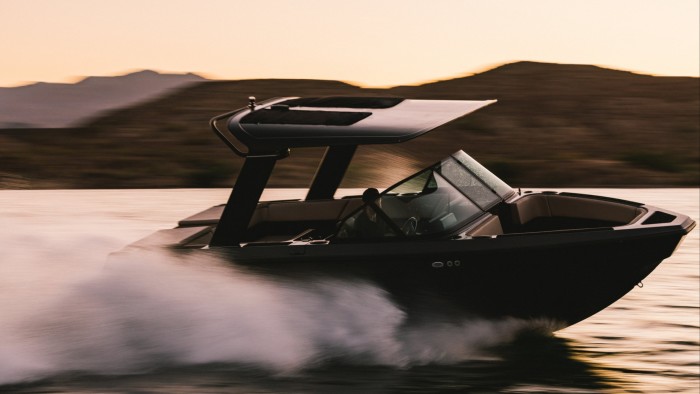Unlock the Editor’s Digest for free
Roula Khalaf, Editor of the FT, selects her favourite stories in this weekly newsletter.
The writer is a contributing columnist, based in Chicago
One of the best things about summer in the American Midwest is Great Lakes boating. I grew up with the noise, fumes and fuel spills inevitable with gasoline-powered motors. But that was back in the 1960s when Midwestern rivers were so polluted that they regularly caught fire. Today, many are looking for ways to clean up boating on the Great Lakes, which hold 21 per cent of the world’s fresh water.
Sleek, silent electric boats have captured the public imagination. Marinas across the midwest are electrifying to prepare for them, Great Lakes ferries are converting to electric power and giant freighters are testing biofuels to reduce emissions. It’s slow going: only a tiny percentage of leisure boats in the Great Lakes states are electric, according to industry experts. They compare the present moment to the earliest days of Tesla.
But even states like Michigan — which helped to catapult President Donald Trump into the White House, along with his plans to cut electric vehicle tax credits — are aiming for carbon-neutrality by 2050. That means boating “eventually needs to be decarbonised”, according to Thomas McKenney, a sustainability expert at the University of Michigan. “Right now you are seeing the leading edge of that; the first movers are demonstrating that it is possible”, he tells me.
Some of the same changes in battery technology that have driven the global boom in electric vehicles are making it possible to electrify boating, industry experts say, adding that Americans love (or hate) the idea of it for many of the same reasons that they love or hate EVs — and not always correctly.
When I polled recreational boaters on a recent Sunday afternoon at Chicago’s Diversey Harbour, they all mentioned either cost — some high-profile models cost $300,000 — or range anxiety. “Running out of power is one thing in the street, but it’s a whole other thing in the middle of Lake Michigan,” said a boater who gave his name as Rick, gesturing at the vast expanse of the 22,000 square mile lake.
But McKenney says most Great Lakes recreational boats are “used very minimally; a lot of the time they are just sitting there”. A park ranger at Diversey Harbour told me he estimates 90 per cent of the time boats there never leave the harbour: “People come to party on the boats and never move.”
Electric boating has its enthusiasts, too. Allison and Anthony Guilliom tell me they spent $300,000 on an Eelex 8000 from Swedish electric boat maker X Shore to use on the island they recently purchased near Belize, where they plan to live off grid. David and Anne Florenzano have been electric boat owners for 25 years: theirs is a far cheaper and simpler 15-foot Budsin Lightning Bug. Their home’s solar roof powers the boat, which they tell me is “the exact opposite” of a noisy, disruptive jet ski. “It’s so quiet and slow, we can sneak up on loons.”
Most maritime experts agree that electrifying pleasure boats isn’t the main goal, though: the Conference of Great Lakes St Lawrence Governors and Premiers, a US and Canadian intergovernmental organisation dedicated to protecting the Great Lakes, found last year that converting freighters to biofuel would achieve the biggest reduction in emissions, followed by electrification of ferries and tugboats. John Schmidt of the group said electrifying Great Lakes 1,000-footers isn’t realistic because they can last 100 years due to operating in fresh rather than salt water — new ships aren’t built often.
McKenney says electrifying every pleasure craft right now doesn’t make sense: “Emissions that go into producing batteries and electric motors at the moment do not justify their use in low utilisation boats.” However, it can make sense for boat clubs or boat shares where usage is higher.
So go ahead and enjoy the silence, the speed and the low fuel costs of that electric boat. But I doubt I’ll see electric boating take over the Great Lakes in my lifetime. We’ve come a long way since the 1960s, but we’ll probably be stuck with the noise and fumes and single-digit mileage of gas-powered motors for some time to come.
